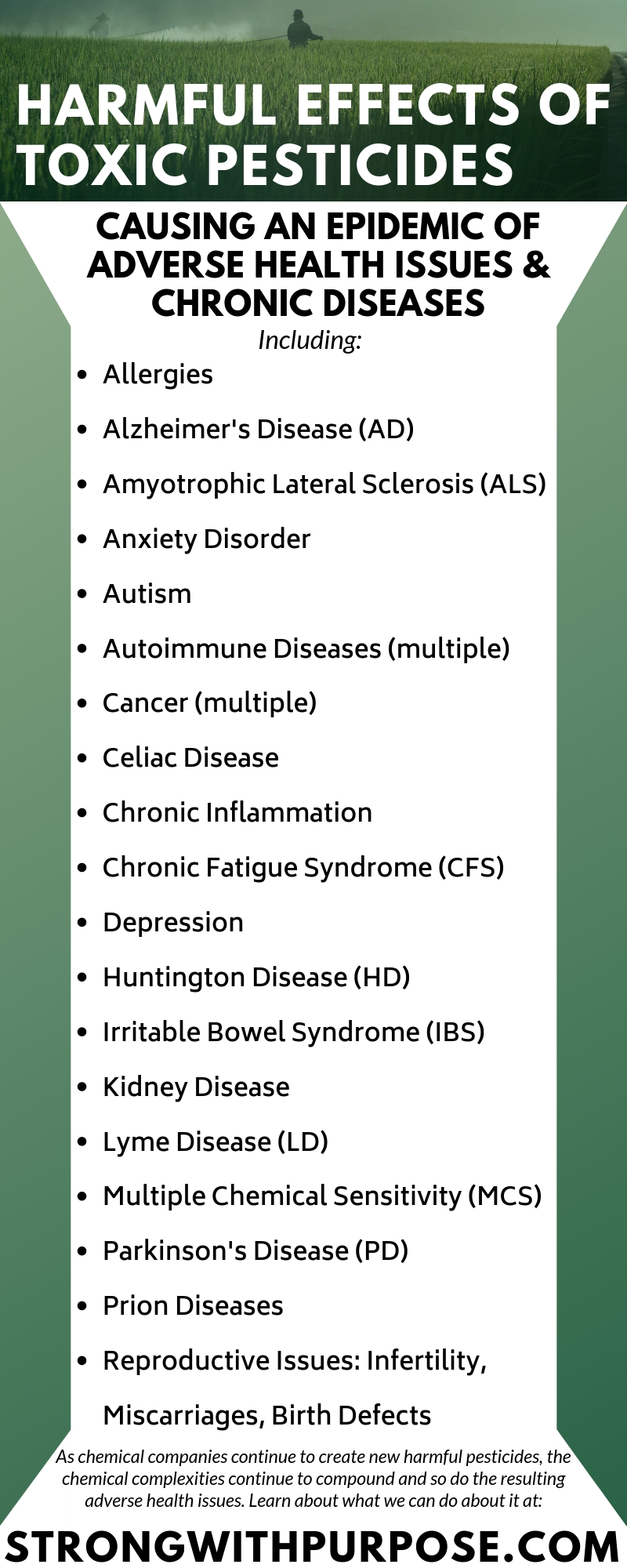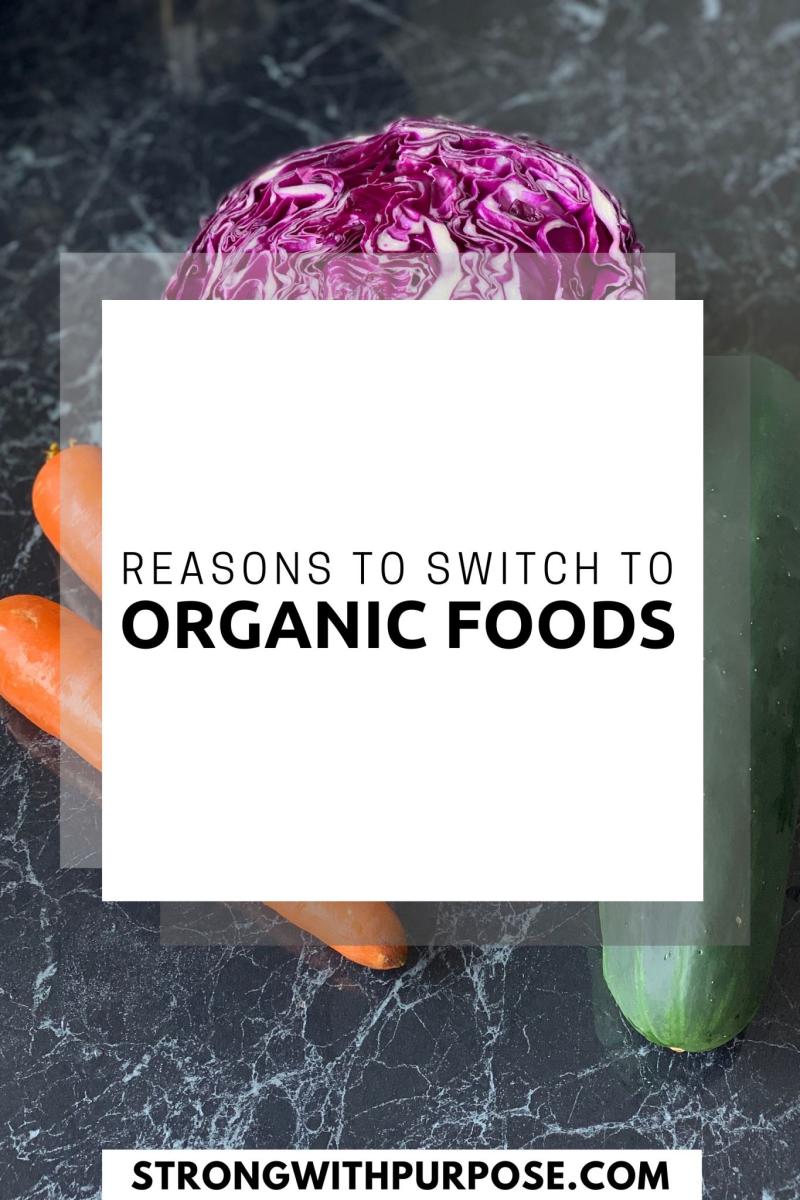How often do you think about the food you consume daily? When it comes to food, most people simply do what they have to do to get by: purchasing conventionally grown foods, eating at restaurants, getting takeout, and consuming what is available and affordable.
In the course of life, oftentimes it’s not until we’re struck with a serious health issue that we begin to seriously examine what we’re habitually eating.
The occurrence of various adverse health issues are on the rise, and a majority of these issues are caused by exposure to pesticides. Whether or not you suffer from one of them, you may know someone—or multiple people—affected by them. These include:
- Allergies
- Alzheimer’s Disease (AD)
- Amyotrophic Lateral Sclerosis (ALS)
- Anxiety Disorder
- Autism
- Autoimmune Diseases (multiple)
- Cancer (multiple)
- Celiac Disease
- Chronic Inflammation
- Chronic Fatigue Syndrome (CFS)
- Depression
- Huntington Disease (HD)
- Irritable Bowel Syndrome (IBS)
- Kidney Disease
- Lyme Disease (LD)
- Multiple Chemical Sensitivity (MCS)
- Parkinson’s Disease (PD)
- Prion Diseases
- Reproductive Issues: Infertility, Miscarriages, Birth Defects

The truth is that an overwhelming amount of evidence is coming to light, but this information is not mainstream knowledge yet. The majority of people are still in the dark when it comes to this topic.
The truth is that there are multiple billion-dollar industries that don’t want you to know the truth, because they profit off the complacency and sickness of innocent people.
The truth is that major government organizations across the world are allowing a multitude of toxins to spread, and we’re all being exposed to them.
I believe that if we spread the truth, we will be able to change the world for the better. Every time we share this information, we are moving that much closer to a healthier world for our generations as well as future generations.
This post is multifaceted and packed with a lot of research because this issue is larger and more complicated than I ever could have imagined. You can choose to read the whole post, or you can read bits of it and share the images I’ve created. Either way, I thank you so much. If you’d rather skip the research and go straight down to the takeaways, click here.

The Problems with Pesticides and Their Widespread Use
Worldwide, the number one glyphosate-based herbicide used is Roundup®. Other trade names of glyphosate-based herbicides include Roundup Ultra®, Roundup Pro®, Accord®, Honcho®, Pondmaster®, Protocol®, Rascal®, Expedite®, Ranger®, Bronco®, Campain®, Landmaster®, Fallow Master® and Aquamaster® manufactured by Monsanto; Glyphomax®, Glypro® and Rodeo® manufactured by Dow Agrosciences; Glyphosate herbicide manufactured by Du Pont; Silhouette® manufactured by Cenex/Land O’Lakes; Rattler® manufactured by Helena; MirageR® manufactured by Platte; JuryR® manufactured by Riverside/Terra; and Touchdown® manufactured by Zeneca. Formulations of glyphosate in salt form include monoammonium salt, diammonium salt, isopropylamine salt, potassium salt, sodium salt, and trimethylsulfonium or trimesium salt. These herbicides are sources of genotoxicity, cytotoxicity, and reproductive toxicity in wildlife and humans. [2]
As of 2014, 100% of all water surfaces and 96% of all fish that were examined contained detectable levels of pesticides. Specifically, glyphosate and the product it degrades into, aminomethylphosphonic acid (AMPA), were detected frequently in in soils, sediment, ditches, drains, rainwater, rivers, and streams. [1]
In the U.S., the EPA-tolerated levels of glyphosate in food residues varies greatly from crop to crop. For example, the tolerances are 200 PPM in peppermint, 100 PPM in one group of cereal, 25 PPM in almonds, 10 PPM in beet roots, 7 PPM in instant tea, and 0.50 PPM in citrus fruits. To see the full table, click here. [3]
Pesticides are a Catastrophic Issue Continuously Becoming More Complex
As glyphosate usage continues, glyphosate resistance among weeds is becoming a growing problem, necessitating a strategy that either involves an increase in the amount and frequency of glyphosate or a supplementation with other herbicides such as glufosinate, dicampa, 2,4-dinitrophenol, atrazine, and many others. Several other ripening agents are also used, including Ethephon, Trinexapacethyl, and Sulfometuron-methyl. Larger amounts are used in regions that are hot and rainy. Agrochemical companies are now actively developing crops with resistance to multiple herbicides, which is a disturbing trend causing a cascade of adverse effects. [3]
In a 2017 study, the toxicity of many different glyphosate-based herbicides and other pesticides were measured. The majority of pesticide formulations tested were found to contain arsenic, chromium, cobalt, lead, and nickel, which are toxic heavy metals that act as endocrine disruptors. The levels of these toxins were found to be between 5-62 times the permitted level. [4]
Another group of harmful pesticides called neonicotinoids have been found to negatively effect the longevity and cognition of honeybees. A newer pesticide called Sivanto® has the active ingredient of flupyradifurone (FPF) and functions nearly the same as neonicotinoids. This pesticide was also found to cause adverse effects in honeybees, including poor coordination, hyperactivity, and apathy. [5]
Chemical companies are continuing to develop new harmful pesticides. As the chemical complexities continue to increase and compound, we can only expect that the resulting health issues will do the same. We have to stop pretending that swapping one pesticide for another will do anything to end this crisis. This insanity has to stop.
Pesticides are Inflaming Our Guts and Brains, Thwarting Our Ability to Detoxify Toxic Substances from Our Bodies
During the last 100 years as a consequence of the industrial revolution, we have introduced many new chemicals to the microbiome that did not previously exist. Newly man-made chemicals including polychlorinated biphenyls and glyphosate cause dysbiosis. [6] Dysbiosis of the human gut microbiota has been functionally associated with central nervous system (CNS) degenerative disorders that include Parkinson’s disease (PD), Alzheimer disease (AD), Huntington disease (HD), and amyotrophic lateral sclerosis (ALS). [7]
Pathophysiological alterations of barrier permeability have been demonstrated to initiate cascades of pro-inflammatory insults to intrinsic cells within superficial and deeper layers, with severe consequences to normal bidirectional gut-brain signaling processes. [7]
Glyphosate causes the depletion of derivatives of the shikimate pathway. Our gut bacteria use the shikimate pathway to supply essential aromatic amino acids tryptophan, tyrosine, and phenylalanine. Many other molecules depend on the shikimate pathway metabolites as precursors, including methionine, glycine, serotonin, melatonin, melanin, epinephrine, dopamine, thyroid hormone, folate, coenzyme Q10, vitamin K, and vitamin E. Disruption of the shikimate pathway causes a cascade of negative effects beginning in the gut and affecting many other vital processes in the human body. [1]
Cytochrome P450 (CYP) enzymes are essential for detoxifying environmental toxins, activating vitamin D3, catabolizing vitamin A, and maintaining bile acid production and sulfate supplies to the gut. [3] Glyphosate has been shown to inactive cytochrome P450 (CYP) enzymes. These enzymes play a critical role in enabling the liver to detoxify xenobiotics, which include all substances foreign to the body. Glyphosate’s disruption of CYP enzymes intensifies the adverse effects resulting from exposure to toxic substances including food borne chemical residues and environmental toxins, thereby playing a role in the increase of multiple chemical sensitivity syndrome (MCS). Glyphosate chelates aluminum and a multitude of other elements, which enables them to readily pass through the gut barrier and into the blood stream and brain. [1]
Dopamine suppresses thyroid stimulating hormone (TSH). Dopamine insufficiency can lead to overactive thyroid and possible burnout of the thyroid gland. Thyroid hormone is derived from tyrosine, one of the essential aromatic amino acids negatively impacted by glyphosate. Glyphosate depletes selenium and methionine, leading to reduced bioavailability of selenoproteins which the thyroid depends critically on as antioxidants. There is a strong correlation of glyphosate application to corn and soy with thyroid cancer. [1]
The integrity of our gut lining depends on commensal bacteria, which are harmed by glyphosate exposure. When the lining is compromised, the nervous system can then be adversely affected. Autism and Parkinson’s disease (PD) are frequently accompanied by digestive and gastrointestinal (GI) issues. [6]
Manganese depletion in the gut due to chelation by glyphosate selectively affects Lactobacillus, leading to increased anxiety via the gut–brain access. Low levels of Lactobacillus in the gut are also features of autism and chronic fatigue syndrome (CFS). [1] Mice studies have shown that chronic disturbances in one’s microbiota, including chronic gastrointestinal (GI) inflammation, can lead to behavioral symptoms that mirror those of anxiety disorder sufferers. One of the most common coexisting disorders for those diagnosed with panic disorder is irritable bowel syndrome (IBS). Inflammation and abnormality in the GI system have been linked with the development of neurological disorders like autism and dementia, as well as neuropsychiatric disorders like schizophrenia and bipolar disorder. [6]
Reducing the diversity and composition of the microbiome has a negative impact on health and the ability of the immune system to appropriately react to self vs. non-self. [6] The results are autoimmune issues, allergies, food sensitivities, and a multitude of degenerative conditions.
Parkinson’s disease (PD) and irritable bowel syndrome (IBS) patients have reductions in the abundance of Prevotellaceae/Prevotella bacteria species and Bacteroidaceae/Bacteroides bacteria species in their gut microbiota. [7]
Exposure to pesticides allows harmful pathogens to thrive in the our gut environments. The pathogen Salmonella is resistant to glyphosate toxicity, so it thrives while more beneficial bacteria are harmed by glyphosate exposure. Reduced Lactobacillus in the gut can lead to an overgrowth of Salmonella. The pathogen responsible for Lyme disease, Borrelia burgdorferi, is also dependent on manganese. Disruption of manganese homeostasis may be a primary cause for the increased incidents of Lyme disease. [1]
Pesticides are Fueling An Epidemic of Chronic Diseases
Disruption of manganese homeostasis can lead to extreme sensitivity to variations in manganese bioavailability. [1]
Too little manganese in the blood leads to impairment of several manganese-dependent enzymes. Low manganese bioavailability from the blood supply to the brain leads to impared function of glutamine synthase and a build-up of glutamate and ammonia in the brain, both which create a neurotoxic effect and are associated with many neurological diseases including autism and Alzheimer’s disease. [1]
Manganese deficiency can also cause poor bone development, leading to osteoporosis and osteomalacia. [1]
With too much manganese, the liver acquires an impaired ability to export it in bile acids. Then, manganese accumulates in the liver and brainstem. [1] This accumulation leads to liver damage, Parkinson’s disease, and prion diseases such as Creutzfeldt-Jakob Disease (CJD), Variant Creutzfeldt-Jakob Disease (vCJD), Gerstmann-Straussler-Scheinker Syndrome, Fatal Familial Insomnia, and Kuru. [1]
Manganese superoxide dismutate (Mn-SOD) is known to protect mitochondria from oxidative damage. However, glyphosate suppresses Mn-SOD, causing mitochondrial damage and dysfunction, which is a feature of many neurological diseases. [1]
Glyphosate exposure inevitably causes Alzheimer’s disease, Parkinson’s disease, anxiety disorder, osteoporosis, inflammatory bowel disease, renal lithiasis, osteomalacia, cholestasis, thyroid dysfunction, and infertility due to glyphosate’s effect of dysregulating manganese utilization in the body. [1]
Pesticides are Contributing to Celiac Disease, Kidney Disease, Chronic Inflammation, & Cancer
Glyphosate residues are found in wheat due to the increasingly widespread practice of staging and desiccation of wheat right before harvest. Many of the pathologies associated with celiac disease can be explained by disruption of CYP enzymes. The increasing trends of celiac disease over time match well with the increase of glyphosate usage on wheat crops. [1]
Celiac disease is associated with a reduced presence in the gut of commensal bacteria such as Lactobacilli and Bifidobacteria, which are known to be preferentially killed by glyphosate, and with an overabundance of C. difficile, which is known to be promoted by glyphosate exposure. [3]
Deficiencies in iron, cobalt, molybdenum, copper and other rare metals associated with celiac disease can be attributed to glyphosate’s strong ability to chelate these elements. Deficiencies in tryptophan, tyrosine, methionine and selenomethionine associated with celiac disease match glyphosate’s known depletion of these amino acids. [3]
Celiac disease patients have an increased risk to non-Hodgkin’s lymphoma, which has also been implicated in glyphosate exposure. [3]
An in vitro study showed that glyphosate in parts per trillion functioned as an endocrine disruptor, altered estrogen receptor expressions, and induced the proliferation of hormone-dependent human breast cancer cells. [1]
Women with celiac disease are known to have higher rates of infertility, miscarriages, and birth defects in their offspring, which can also be explained by glyphosate. There has been a recent 4-fold increase in developmental malformations in the province of Chaco, Argentina, where glyphosate is used massively on GMO monocrops of soybeans. In Paraguay, 52 cases of malformations were reported in the offspring of women exposed during pregnancy to agrochemicals, including anencephaly, microcephaly, facial defects, cleft palate, ear malformations, polydactily, and syndactily. In in vitro studies on human cell lines, DNA strand breaks, plasma membrane damage and apoptosis were observed following exposure to glyphosate-based herbicides. Another factor in teratogenetic effects of glyphosate may be the suppression of the activity of androgen-to-estrogen conversion by aromatase, a CYP enzyme. [3]
Mechanistic studies of glyphosate-induced immunosuppression/inflammation, endocrine disruption, genetic alterations, and oxidative stress suggest plausible links between glyphosate-based herbicide exposure and Non-Hodgkin Lymphoma development. [8]
Glyphosate is highly corrosive to the esophageal epidermal lining and can cause gastrointestinal (GI) tract injury, oropharyngeal ulceration, nausea, and vomiting. Glyphosate exposure can induce eosinophilic esophagitis (EOE), which is related to food sensitivities, but airborne exposure to chemicals in the lungs can also induce it. [3]
Glyphosate can produce toxic effects on the kidneys. Kidney disease is often associated with increased levels of celiac disease antibodies. Like in celiac disease, inflammation plays a crucial role in the progression of kidney disease. Chronic kidney disease is increasing at an alarming rate for Central American agricultural workers, especially in sugar cane fields where workers are exposed to excess glyphosate. [3]
Celiac disease is associated with multiple pathologies in the digestive system, including impaired gall bladder function, fatty liver, pancreatitis, and EOE. These problems can be traced to impaired CYP function in the liver due to glyphosate exposure, leading to insufficient flow of bile acids through the circular pathway between the liver and the gut. This results in a system-wide depletion in sulfate, which induces inflammation in multiple organs to produce sulfate locally. A potential sulfur source for sulfate synthesis could be hydrogen sulfide gas, provided in part by the local breakdown of sulfur-containing amino acids like cysteine and homocysteine and in part by diffusion of the gas produced from inorganic dietary sources by sulfur-reducing bacteria in the large intestine. [3]
The undiagnosed celiac disease is associated with a fourfold increased risk of death, mostly due to increased cancer risk. The prevalence of undiagnosed celiac disease has dramatically increased in the USA during the past 50 years, coinciding with the introduction of Roundup to the market. [6]
Pesticides are Disrupting of the Development of Babies & Children
Manganese deficiency caused by pesticide exposure can account for poor sperm mobility, leading to low fertilization rates and birth defects. [1]
In early life, environmental disturbances to the microbiota, including the exposure to antibiotics or being born by cesarean section, may affect not only the immune system but the host’s neurobiology as well, interrupting proper brain development and increasing the risk for a wide range of health issues, including cognitive deficits, altered dynamics of the tryptophan metabolic pathway, and significantly reduced brain-derived neurotropic factor (BDNF), oxytocin, and vasopressin expression in the adult brain. [6]
The full potential of the developing infant’s microbe is unlocked only when it feeds on breast milk. [6] Additionally, mothers should avoid all antibiotics including glyphosate which is found in non-organic foods. Mothers can positively impact their children’s development by breastfeeding and consuming organic foods.
Pesticides are Causing Allergies, Immune Responses, & Food Sensitivities
Unpredicted mutations in the GM soy DNA were discovered, which may produce new allergens. The increased residue of Roundup herbicide in GM soy might contribute to increased allergies. The symptoms identified in a U.K. soy allergy study are among those related to glyphosate exposure. The allergy study identified irritable bowel syndrome, digestion problems, chronic fatigue, headaches, lethargy, and skin complaints including acne and eczema. Symptoms of glyphosate exposure include nausea, headaches, lethargy, skin rashes, and burning or itchy skin. It is also possible that glyphosate’s breakdown product, AMPA, which accumulates in GM soybeans, might contribute to allergies. [9]
Mice fed GM soy had reduced levels of pancreatic enzymes. When protein-digesting enzymes are suppressed, proteins may last longer in the gut, allowing more time for an allergic reaction to take place. Any reduction in protein digestion could therefore promote allergic reactions to a wide range of proteins, not just to the GM soy. [9]
Corn and cotton varieties are engineered to produce an insecticide called Bt-toxin. The Bt-toxin is produced in every cell of genetically engineered crops and it ends up in all products derived from corn and cotton. When mice were exposed to Bt-toxin, they not only mounted an immune response to it directly, but they subsequently reacted to foods that had not formerly triggered a response. There was something about the Bt-toxin that primed the immune system to become reactive to other, once benign, foods. Eating GM corn could directly lead to the development of gluten or other food sensitivities. [10]
Immune responses are triggered in humans by the Bt-toxin in spray form and GM crops. In the Philippines, workers who inhaled GM corn pollen reported asthma, breathing difficulties, swollen faces, flu-like symptoms, fever, and sneezing. In India, cotton workers who inhaled Bt-toxin spray reported sneezing, runny nose, watery eyes, skin eruptions, itching and burning, red skin and eyes, facial swelling, and fever. Individuals in the Philippines and India also reported long-term effects after exposure, including coughs, headache, stomachache, dizziness, diarrhea, vomiting, weakness, and numbness. [9]
In Conclusion
Glyphosate has multiple toxic effects in the human body, including (1) disrupting the shikimate pathway, (2) altering the balance between pathogens and beneficial biota in the gut, (3) chelating transition metals, as well as sulfur and selenium, and (4) inhibiting cytochrome P450 enzymes. [3]
This is not just a U.S. problem, this is a worldwide problem. Chronic exposure to even a small amount of glyphosate over the course of time will lead to a system-wide deficiency in the supply of sulfate to the tissues as well as chronic inflammation. This is the most important consequence of glyphosate’s insidious slow erosion of health. Chronic inflammation is a major source of oxidative stress and is estimated to account for one third of all cancer cases worldwide. [3]
Exposure to pesticides causes cascading effects, leaving us vulnerable to a multitude of other potential exposures. As chemical companies continue to create new harmful pesticides, the chemical complexities continue to compound and so will the resulting adverse health issues.
These problems are widespread and catastrophic as they negatively impact all humans, animals, plants, and our environment. It’s time for us to wake up and take action towards creating a healthy future.
What Can We Do?
Healing Begins in the Gut
Our guts are a vast ecosystem of different bacterial species. The ecosystem of bacteria in our guts is being actively created as we go about our daily activities of eating and drinking. Each consumption choice we make directly impacts our gut bacteria. As a normal human, we rarely think about the existence of specific bacterial species in our guts. This information only become interesting to us when we start experiencing severe gut issues, indigestion, and autoimmune issues.
With deliberate effort, it is possible to heal chronic and debilitating conditions. By consuming lots of organic fruits and vegetables, we are able to reclaim our guts. By eating with our guts in mind, we can help facilitate the multiplication of good bacteria species and the eradication of the bad species. By making healthy choices, our guts heal along with our brains and we begin to feel much better physically, mentally, and emotionally.
In other words, this involves:
(1) Introducing bacteria to the gut that supply beneficial metabolites;
(2) Recolonizing the gut with commensal bacteria;
(3) Providing prebiotics that feed the endogenous and exogenous commensal bacteria but not the pathogenic bacteria;
(4) Supplying the gut with amino acids that are known to be beneficial to building the integrity of the intestinal lining and in rebuilding the microvilli of the gut’s epithelial cells;
(5) Providing the gut and hence the circulation and brain with postbiotic anti-inflammatory molecules. [6]
Additionally, exercising and eating a high fiber diet will have positive effects on the microbiome and brain structure. Organic food is advised given the food supply is tainted with many toxins, antibiotics, and pesticides. [6]
In regards to cases of severe illness, it is worthwhile noting that living in nature without modern chemical contamination can lead to a significant reduction of chronic inflammatory states and conditions. [6]
Overcome Our Cravings & Break the Cycle of Eating GMOs
If we’re not intentionally consuming organic foods, then we are consuming genetically modified foods produced using harmful pesticides. Once you break the cycle of eating genetically modified foods, I promise you it will become a whole lot easier to continue eating healthier.
Gut bacteria send signals to our brains requesting more of the food that introduced them. Certain bacteria send stronger signals than others. Certain foods are intentionally bio-engineered to cause us to experience severe and uncontrollable cravings. Food manufacturers know that once we experience a certain reaction in our bodies, we crave more, and we’re likely to continue indulging in those cravings. The more frequently we indulge in the same cravings, the greater quantity of those specific gut bacteria are created in our bodies, continuing to fuel the cycle of cravings.
Oftentimes we feel like we’re at the mercy of the biological responses in our bodies. However, once we’re able to have a deeper understanding of the nature of these processes, we are able to reclaim what is ours. We are able to make choices that make our bodies feel good rather than bad. We are able to overcome severe cravings that were bio-engineered to make us desire more and more.
On this topic, I’d like to share a non-science-based, experienced-based example from my life. When we eat anything from Taco Bell, we consume many genetically modified ingredients, and these introduce certain gut bacteria species into our internal ecosystems. There was a time in my life that I ate Taco Bell multiple times a week. Once I started craving it, I would re-feed those gut bacteria and continue the cycle. At that time in my life, I was not aware of what was happening in my body—I just had an uncontrollable desire for Taco Bell. This is no longer the case, but on New Year’s Day, I ate some Taco Bell. In less than 8 hours, my body was physically shaking and craving it severely. The desire to re-feed those gut bacteria was overwhelming and I almost caved in. This time, I was aware of exactly what was happening in my body. Instead of allowing those cravings to take control of my actions, I resisted the temptation and consumed something organic instead. Personally, eating Taco Bell creates a drug-like addictive response in my body. I haven’t had Taco Bell since then, and I don’t miss it.
In this post, I share the whole story about how I overcame my body’s cravings, stopped binge eating, healed my relationship with food, and lost 55 lbs in the process.
Fall in Love with the Way You Eat
Take it one step at a time. Every little bit of healthy intention counts, adds up, and multiplies in time. Try making one small change at a time, and don’t give up! Healthy habits breed more healthy habits. Eating right begins with how you do your grocery shopping and cooking.
Choose Organic
Always choose to buy and eat organic foods whenever possible. By buying organic, we are voting with our dollars. Look for the “Certified Organic” seal. If there is no organic option available, look for the “Non-GMO Project Verified” seal.
Eat Seasonally & Shop Local Farms
You will notice the available produce at the grocery store shift and change throughout the seasons. Aim to eat what is currently in season. If there is a local community supported agriculture (CSA) in your area, this can make the process even easier and more delicious.
If you’re located in Michigan, you can order a wide variety of organic and non-GMO meats and other products to be picked up at a nearby location or delivered straight to your home from Michigan Farm to Family.
Save Money on Organic Products
You can save money on organic products by shopping online and purchasing products that are on sale. Some of the best online stores include Vitacost, iHerb, Thrive Market, and FreshDirect. You can also save money on your in-person grocery shopping trips by signing up with Ibotta and getting rebates. Check out this post for a few more tips on how to save money on organic products.
Eat the Rainbow
When it comes to the colors of fruits and vegetables, aim to eat all colors of the rainbow so you get all the wonderful benefits of the different phytochemicals, antioxidants, vitamins, and minerals. In this post, I share more info about eating the rainbow and creating nutrient-dense stews. I’ve also shared recipes for a wild rainbow salad and a delicious chicken noodle soup.
Eat to Your Body’s Needs
If you suspect you have any food intolerances, you can order an at-home test to get some clarity. You can then use those test results to make an informed decision about which foods to each and which foods to avoid.
Show You Care and Spread the Knowledge
Urge your local, state, and federal governments to reexamine their policies towards pesticides and other toxic chemicals, and encourage them to introduce new legislation that would restrict their usage.
Urge nearby local businesses to make organic the standard—this includes in all restaurants, schools, hospitals, and stores.
Share this post with everyone you know & love! Let’s all wake up together and make healthier choices that benefit us as well as future generations.
References
[1] Samsel, Anthony and Stephanie Seneff. “Glyphosate, pathways to modern diseases III: Manganese, neurological diseases, and associated pathologies” Surgical neurology international vol. 6 45. 24 Mar 2015.
[2] Mensah, Paul K., Carolyn G. Palmer, and Oghenekaro N. Odume. “Ecotoxicology of Glyphosate and Glyphosate-Based Herbicides — Toxicity to Wildlife and Humans” IntechOpen. 22 July 2015.
[3] Samsel, Anthony and Stephanie Seneff. “Glyphosate, pathways to modern diseases II: Celiac sprue and gluten intolerance” Interdisciplinary toxicology vol. 6,4 (2013): 159-84. Dec 2013.
[4] N. Defarge, J. Spiroux de Vendômois, G.E. Séralini. “Toxicity of formulants and heavy metals in glyphosate-based herbicides and other pesticides” Toxicology Reports, Volume 5. 30 Dec 2007.
[5] Tosi S. and Nieh J. C. “Lethal and sublethal synergistic effects of a new systemic pesticide, flupyradifurone (Sivanto®), on honeybees” Proceedings of the Royal Society B: Biological Sciences, 286. 10 Apr 2019.
[6] Maguire, Mia and Greg Maguire. “Gut dysbiosis, leaky gut, and intestinal epithelial proliferation in neurological disorders: towards the development of a new therapeutic using amino acids, prebiotics, probiotics, and postbiotics” Reviews in the Neurosciences, 30.2 (2018): 179-201. 03 Sep 2018.
[7] Stefano, G.B., Pilonis, N., Ptacek, R. et al. “Gut, Microbiome, and Brain Regulatory Axis: Relevance to Neurodegenerative and Psychiatric Disorders” Cell Mol Neurobiol (2018) 38: 1197. 25 May 2018.
[8] Luoping Zhang, Iemaan Rana, Rachel M. Shaffer, Emanuela Taioli, and Lianne Sheppard. “Exposure to Glyphosate-Based Herbicides and Risk for Non-Hodgkin Lymphoma: A Meta-Analysis and Supporting Evidence” Mutation Research/Reviews in Mutation Research. 10 Feb 2019.
[9] Smith, Jeffery M. “Genetically Modified Foods Unsafe? Evidence that Links GM Foods to Allergic Responses Mounts” Global Research. 8 Nov 2007.
[10] Smith, Jeffrey M. “Are Genetically Modified Foods a Gut-Wrenching Combination?” Institute for Responsible Technology. Nov 2013.





Pingback: How I Overcame Self-Destructive Habits and Began My Healing Journey | Strong with Purpose | Mindfulness, Healing, Living
Pingback: How to Start Your Blog and What I Wish I Knew When I Started Mine | Strong with Purpose | Mindfulness, Healing, Living
Pingback: How to Shop Smarter and Save Money at Whole Foods | Strong with Purpose | Mindfulness, Healing, Living
Pingback: How I Overcame Self-Destructive Habits and Began My Healing Journey | Strong with Purpose | Spirituality, Healing, Intuitive Living
Pingback: A Kale Salad Worth Making | Strong with Purpose | Spirituality, Healing, Intuitive Living
Pingback: 5 Natural Remedies to Improve Your Eye Health | Strong with Purpose | Healing & Intuitive Living
Pingback: 9 Ways to Soothe Your Soul from the Inside Out | Strong with Purpose | Healing & Intuitive Living
Pingback: Gluten Free + Dairy Free Crispy Chicken Thighs | Strong with Purpose | Healing & Intuitive Living
Pingback: Why + How to Reduce Your Sugar Intake | Strong with Purpose | Healing & Intuitive Living
Pingback: The Health Benefits of Blueberries | Strong with Purpose | Healing & Intuitive Living
Pingback: How to Choose Healthy Personal Care Products | Strong with Purpose | Healing & Intuitive Living
Pingback: A Simple Snack Using Canned Chickpeas | Strong with Purpose | Healing & Intuitive Living